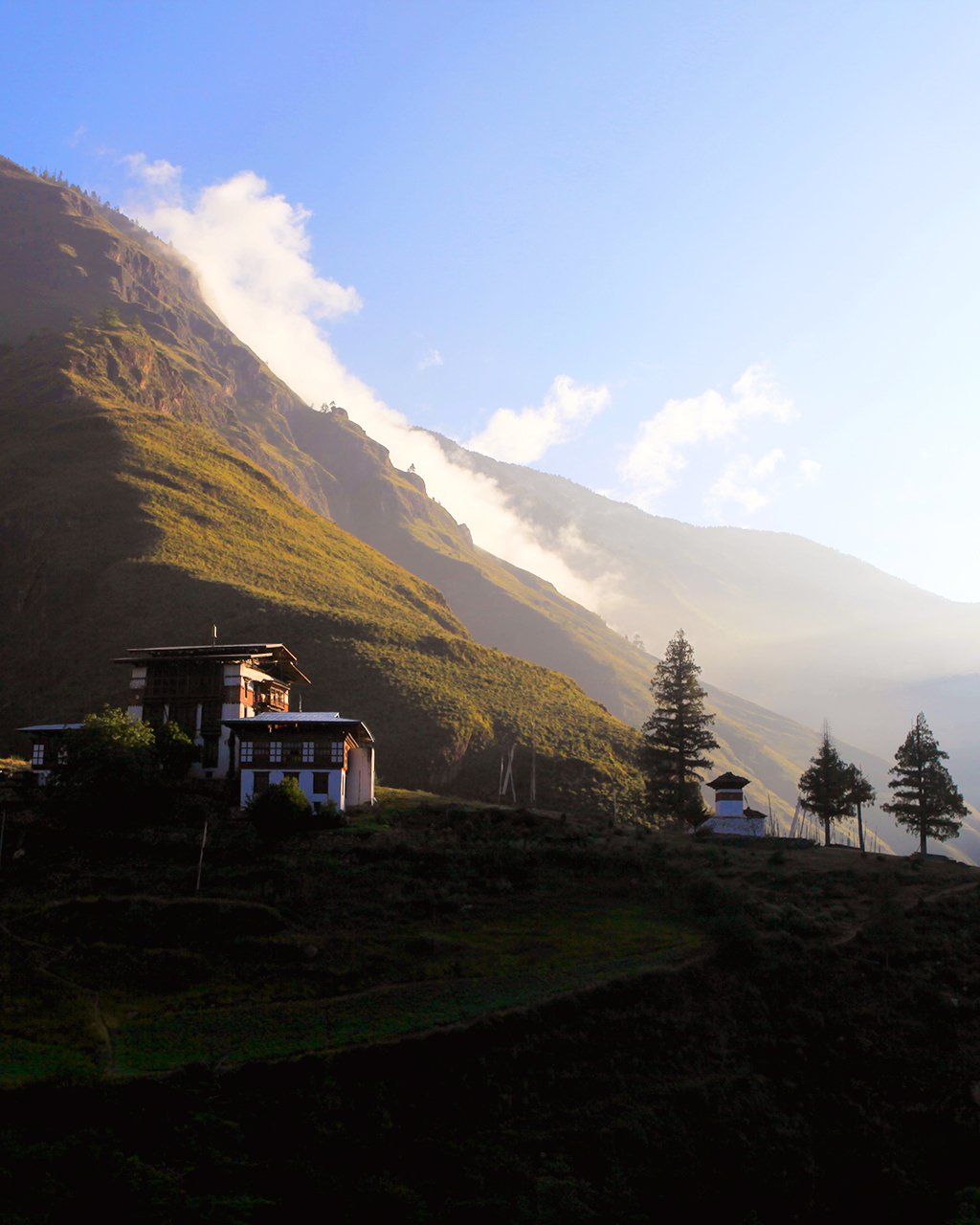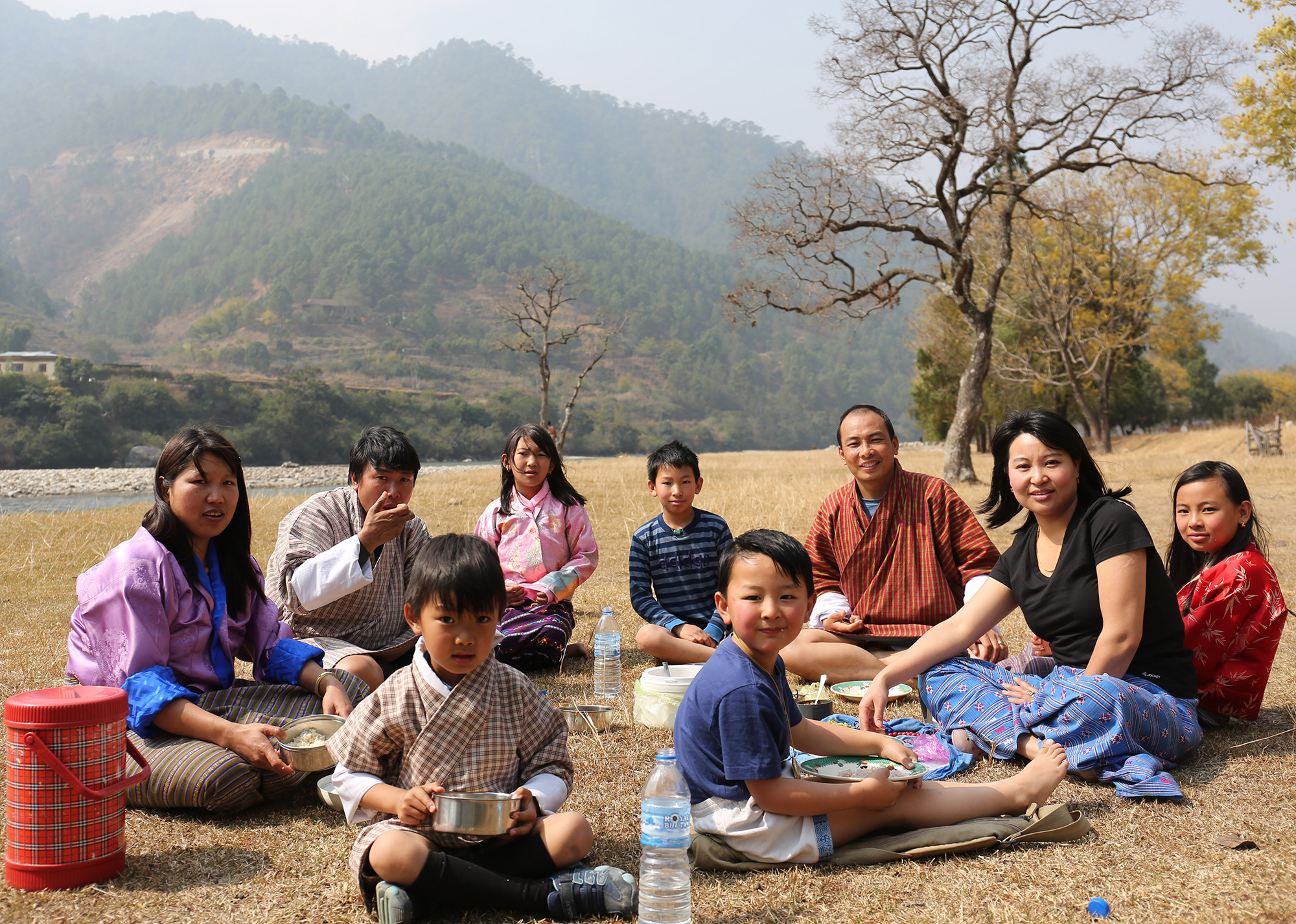Introduction
My first visit to Bhutan was in 2014, along with my husband Jeeth. We spent a month travelling around the country with Ugyen and Gyelmo, a Bhutanese couple whom Jeeth had befriended on earlier trips while exploring ecotourism opportunities. Having been a practicing architect for nearly 20 years, I was excited to experience the wonder conjured up by the thought of the tiny mountain kingdom.
At first glance, Bhutan is breathtaking. The mountains and forests are a soaring and imposing landscape in myriad hues, interspersed with the unique architecture of its distinct Tibetan Buddhist heritage. I was charmed and delighted at the visions of harmony and community conjured up by the bucolic scenes in rural Bhutan – farmhouses nestled amongst the fields; chortensChorten or Stupa is an important religious monument in Buddhism, symbolizing Buddha’s presence. It also holds precious Buddhist relics and sometimes even preserved bodies of renowned lamas. Read more about Chortens on Tibetpedia Read more about Chortens in Bhutan in this article in the Bhutanese Daily BBS. More and prayer flags laid out along the winding mountain paths; the majesty and wonder of the numerous dzongsDzongs are the fortress-monasteries of Bhutan and Tibet. The presence of Dzongs across the country symbolizes unification and the recognition of a central authority by the people in the region. Read More. Everywhere we looked, we saw a continuity of traditional methods of construction and design. Like many other visitors, I felt as though the country had held on to its cultural identity and sustainable lifestyle.
It was while visiting the cities like Thimphu and Phuentsholing that the contrast between the rural and urban became evident, and flooded my mind with questions. Why were there so many box-like apartments in a country with such a small population and sufficient land? Why were most of the architectural elements in the city buildings superficial recreations in cement? Why had concrete and steel taken over mud and timber as building materials? What did the people of the country feel about these changes? In the process of trying to articulate these questions, I realised that the Bhutanese context represented, in a clear and direct way, the challenges and dilemmas facing contemporary architecture in most developing countries today.

We decided to chronicle the stories that they shared with us of their lives, charting their journeys through the country they call home. Through the private and public spaces they have inhabited, and their memories of change in those spaces, we can attempt to understand the challenges of transition, aspirations for the future, and contradictions of the present inherent to many young families. Through the experiences of their three children, Kuenden, Sumchog and Kuenkuen, we see the evolving culture of today and the trajectories of the future, and we can attempt to identify potential points of intervention in order to effect change.
Looking at these stories through the lens of architecture and planning allows us to make connections – how the built environment impacts one’s way of life and reinforces an identity, and how the sustainable principles of traditional architecture are a fundamental part of how Bhutanese define themselves and their country. We also identify and acknowledge the architectural trends that currently influence development in Bhutan.

Bhutan is at a point in its history where we can witness the simultaneous changes in society and architecture as they happen. It presents us with a unique opportunity to identify missteps before they occur and suggest interventions which are suitable. In our time in Bhutan we have realised the possibilities of truly sustainable and conscious development, initiatives which could be outstanding examples for the world. In the story of Bhutan we see hope, which we hope to share with the reader.

Lovely! Looking forward to the next post.
Such a pleasure to travel those untrodden paths through your tales…Way to go dear Natasha 😍
Keep walking 🥂
The questions you raise about the inability of contemporory architecture to respond to sustainability and aesthetics is universal.The crafts men are now disconnected from the new materials and building activity has become purely utilitarian.
With the speed at which we want to do things not only architecture food ,clothing and many other things too have utilitarian bereft of celebration and romance.
Your honest search without over romanticising the past and not diluting aspirations of today can help redefine the architecture and building activity .
Its refreshing to see the honesty in your observations which has evolved with rigorous practice
You have articulated very interesting questions to dwell on.
Looking forward to subsequent posts.
About 12 years back, I had studied on Bhutanese model of development measured in terms of GNH (Gross National Happiness) as against GDP model of development for most other countries including India. Since then, it has been my desire to visit Bhutan. Hope to make it some day and get a more direct experience of the community. Being a Buddhist country, the core values of following the “middle path”, “moderation” in sensory pleasures seems deeply ingrained in their value systems.
A delightful sojourn in a land of spellbinding beauty – a place we’ve not had the pleasure to visit yet. Charmed to learn more about the Bhutanese people and their ways, – brought alive through your writing and the lovely pics. The challenges and the questions raised become even more relevant for a place yet not completely exploited and moderately insulated. Eagerly look forward to the stories ahead – and as a beneficiary of your style of traditional, aesthetic and sustainable architecture (and community living) – am sure this blog will serve as a torch-bearer for the people and the architects in the region and elsewhere.
Your words also made the lines of Knopfler ever more potent to me:
“This is all the heaven we’ve got
Right here where we are
In our Shangri-la …”
Very well written..Natasha !